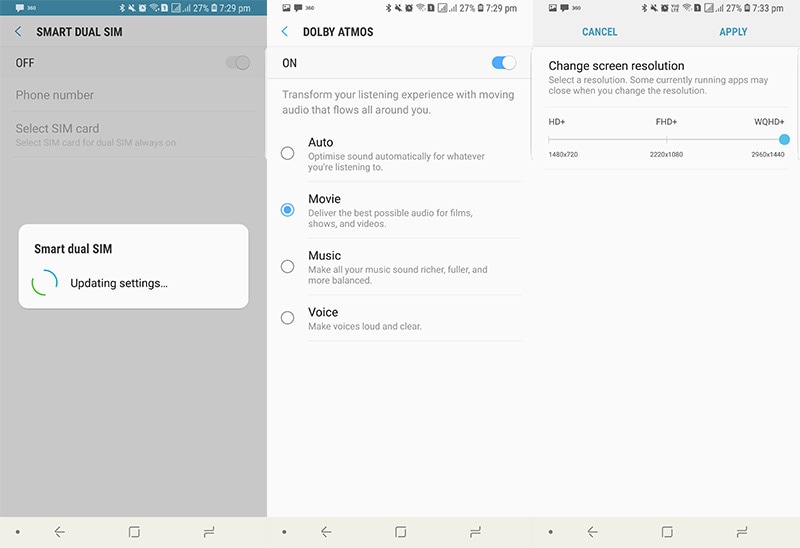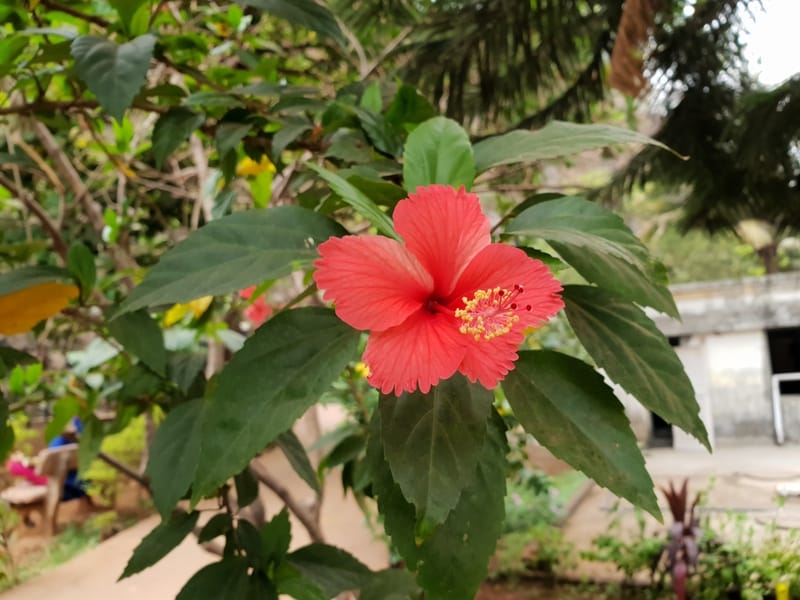
Samsung’s flagship smartphones, the Galaxy S and Galaxy Note series, play a pivotal role in the company’s ability to dominate global markets. Last year’s Galaxy S8, Galaxy S8+and Galaxy Note 8 (Review) helped Samsung capture a big chunk of the global market in 2017, passing Apple along the way, and the company hopes to achieve even better results with its 2018 updates. The Galaxy S9 and Galaxy S9+ have been launched in India very shortly after being announced globally at MWC 2018, for the same starting prices as last year’s models. This is good news for all those who were planning on picking either one up on launch day.
The company has also made a bold move by increasing the disparity between the two models, so for buyers, it isn’t just a case of choosing the display size and battery capacity that suit you better. The big question for us is how much better are the new Galaxy S9 and Galaxy S9+ than their predecessors? If you’re wondering whether you should bother upgrading, read on.
Samsung Galaxy S9 and Galaxy S9+ design and build quality
We begin with the design, which has gotten some minor improvements, but is still very similar to last year’s models for the most part. This is not a bad thing, considering that we loved the design of the Galaxy S8 series. You get the same premium blend of glass and metal. The Galaxy S9 is definitely easier to handle and live with due to its smaller footprint and lower weight, but both phones have the same thickness of 8.5mm. The exposed aluminium sides offer enough surface area to grip the Galaxy S9 when lifting it or when you’re on a call, but its front and back can be slippery. The Galaxy S9+ is definitely a handful in the literal sense, and is a little tough to manage with just one hand. Also, due to the near bezel-less design, we often had many accidental screen touches with the bigger model.
The glass back lets you charge the phone wirelessly and also perform contactless payments through Samsung Pay. However, it’s a major fingerprint magnet. It doesn’t take much to get a lot of smudges on the back. The display is a bit more resilient. Both phones have the same display sizes and resolutions as their predecessors. You get a 5.8-inch display on the Galaxy S9, and a 6.2-inch display on the Galaxy S9+. Both are Super AMOLED panels with an 18.5:9 aspect ratio and a native resolution of 1440×2960 (Quad HD+).
For some reason, Samsung continues to ship its flagships with the screen resolution set lower resolution by default, but this can be changed in the Settings app. We found the default colour saturation level too jarring, but dropping this down to the ‘Basic’ colour profile felt much better. Both displays also support HDR, which we’ll talk about later on.

The physical buttons have good feedback and are easy to reach on the Galaxy S9, but predictably, less so on the Galaxy S9+. We often fond ourselves shuffling the larger model around in our palm in order to get to the volume and power buttons on the side. The dedicated Bixby button is still present, and cannot be re-mapped to perform any other function. A single press takes you to Bixby’s home screen, which offers card-based information about places around you (powered by Foursquare), news (powered by Flipboard), and even updates from installed apps such as Twitter, Uber, etc.
Holding down the Bixby button lets you use voice commands. For instance, you can ask it to send a message to someone through WhatsApp, followed by the actual message. In practice, we found that Bixby worked decently well, as long as we phrased our commands correctly. Samsung provides a list of suggested voice commands for some popular apps. Bixby has even more functions, which we’ll get into soon.
We’re happy to see Samsung still hanging on to the 3.5mm headphones socket, and there’s also a USB Type-C port and a speaker on the bottom of each phone. Both Galaxy S9 phones vibrate slightly for haptic feedback when you press their on-screen Home buttons. There’s a dual Nano-SIM tray on the top, with the provision for a microSD card for storage expansion (up to 400GB). The Galaxy S9 unit that we received for review wasn’t an Indian retail unit, which is why it only had a single SIM slot. Both phones also have RGB notification LEDs.

Samsung has changed the backs of these phones compared to the Galaxy S8 series, and it’s for the better. The fingerprint sensors are now a lot more accessible and are actually useful, as compared to their awkward placement on the Galaxy S8 models. It’s also easy to distinguish them from the camera modules by touch, thanks to the prominent ridges around them. The heart rate sensors are still present, and take their place below the LED flashes on each phone. With the Galaxy S9+, you get a second camera with a telephoto lens, which sits just below the primary camera. The camera bumps on both phones are negligible in thickness, and the phones don’t rock when placed on a flat surface.
The Samsung Galaxy S9 and Galaxy S9+ have very good build quality and look every bit as premium as you’d expect from a flagship smartphone in 2018. Samsung sent us the Lilac Purple and Midnight Black versions, and there’s also a Coral Blue option to choose from, though surprisingly the Titanium Grey version hasn’t come to India (yet). In each phone’s box, you get an AKG-tuned headset, a power adapter with fast charging support, a Type-C cable, a SIM eject tool, a silicone case, and a USB Type-C to Type-A adapter for migrating data from your old phone.
Samsung Galaxy S9 and Galaxy S9+ specifications, software, and features
Each new wave of flagships brings refreshed specifications, and for 2018, Samsung is using either the Qualcomm Snapdragon 845 mobile platform or its own Exynos 9810 SoC, in different countries. As always, India gets the Exynos variants of both phones. This chip features a cluster of four custom CPU cores and a lower clocked cluster of four Cortex-A55 cores. It features the new Mali-G72 GPU, which promises up to 20 percent better performance than that of its predecessor. Now, you’re probably thinking, is this better than the Qualcomm chip? It’s hard to say without actually testing both versions side-by-side, but on paper, they both promise similar features and capabiltiies. Both are built on Samsung’s second-gen 10nm FinFET process, both have eight cores, and both support 4K displays. You get Gigabit LTE modems and improved efficiency in augmented reality applications with either chip.
| Samsung Galaxy S9+ | Samsung Galaxy S9 | |
|---|---|---|
| AnTuTu | 2,51,387 | 2,49,260 |
| PCMark (Work 2.0) | 5,350 | 5,429 |
| GFXBench (T-Rex) | 60 | 60 |
| 3DMark | ||
| Standard | Max | Max |
| Unlimited | 39,049 | 39,923 |
| Geekbench | ||
| Single | 3,760 | 3,719 |
| Multi | 8,869 | 8,971 |
| Basemark Web 3.0 | 203.8 | 220 |
| Octane 2.0 | 13,065 | 14,331 |
Samsung has also made a bold decision when it comes to the amount of RAM it has used for these two devices. The Galaxy S9 gets only 4GB of RAM while the Galaxy S9+ gets 6GB of RAM. Looking the benchmark scores, at least, there doesn’t seem to be much of a performance tradeoff. The performance of both phones are nearly on par. In fact, we got slightly higher scores in some tests on the Galaxy S9 than the S9+. The amount of onboard storage is the same for both models, starting at 64GB though you can choose 256GB variants of each, at higher prices.
Other specifications that are common to both phones include dual-band Wi-Fi 802.11ac with MU-MIMO antennas, Bluetooth 5, NFC, USB-OTG, GPS, 4G VoLTE, and a suite of sensors which include a barometer, a Hall sensor, and a pressure sensor in addition to the usual suspects. Both phones are IP68 dust- and water-resistant, which allows them to survive being submerged in up to 1.5m of fresh water for up to 30 minutes.
Both phones come with the Samsung Experience 9, which is based on Android Oreo 8.0. Both also show that they have received recent security patches. Our Galaxy S9 unit got the March 2018 security update during our review period, though it’s yet to be rolled out to the Indian version of this phone. Our Galaxy S9+ was running the January update. This is not the latest version of Android (8.1), but it’s still a good sign, because one thing that Samsung needs to improve on is the timeliness of its Android updates.
The Galaxy S8 and S8+ only recently began receiving the Oreo update, only to be halted due to a software glitch, which was thankfully sorted out a week later. The Galaxy Note 8, which was Samsung’s top-tier offering till just now, is yet to receive Oreo, which is a huge surprise. In contrast, Sony began issuing Oreo updates for its premium offerings back in October last year, while HTC did the same for the U11 a month later. Thankfully, both new phones are said to have support for Project Treble (Google’s solution to break the update bottleneck created by OEMs). Android P is right around the corner and, Samsung simply does not have an excuse to lag behind Google’s update cycle anymore.
There’s a lot going on in terms of features, gestures and shortcuts, and most of them will be instantly familiar to anyone who’s used Samsung’s previous generation flagship smartphones. The number of customisation options can be overwhelming for first-time users but for those that love tweaking their phones and setting up shortcuts for every little thing, the Samsung Experience has you covered.

You can customise the phone with wallpapers, icons, and themes from a dedicated online store; create pop-up windows for certain apps which can be resized or minimised into floating balloons for easy access; use gestures to trigger one-handed mode or capture a screenshot; set up a custom message and contact for SOS mode; and use the fingerprint sensor to pull down the notifications shade. The Always On display also has a tonne of customisation options, such as different clock styles. Like with previous models, there are interactive widgets for music controls, today’s schedule, and the next alarm.
For the new Galaxy S9 series, Samsung has added a security feature called Intelligent Scan, which essentially combines iris recognition and face scanning when you’re unlocking either phone. However, this mode doesn’t quite live up to its name, and can be annoying. For starters, the phone won’t unlock if you have sunglasses on, and unfortunately, there’s no raise-to-wake gesture which means you have to press either the power button or the virtual home button in order to wake the screen.
There were moments during our review period when it worked quickly, but more often than not, we found it to be slow and very inconsistent. Even though Samsung says that both iris and face biometrics are used in this mode, it doesn’t need data from both scans to work. In some cases, the phone unlocked itself even when our eyes were closed, which suggests that it falls back to just face recognition when the user’s irises aren’t scanned. That leaves us with some doubts about its usefulness compared to just using face recognition on its own.

On the other hand, the iris scanner was usually quicker and worked even in complete darkness. If you’re in a moving vehicle or walking, however, it’s tricky to get this to work as your eyes need to be aligned with the sensor. Face unlocking is easier to use but is potentially less secure and doesn’t work in low light at all. In the end, we simply wound up using the fingerprint sensor more often than any of the other biometric modes, as it’s the most reliable, and the scanner is now easier to reach at the back.
Samsung has its own cloud service and gives you 15GB of storage for backing up your photos and videos, Samsung Notes, contacts, calendar entries, reminders, and keyboard settings. Samsung Pass lets you use your biometrics to log in to websites, but this only works in Samsung’s own browser. Samsung Pay is supported and works well. The Device Maintenance app lets you check your battery usage and switch between Game, Entertainment and High Performance modes, each of which lets you customise the screen’s brightness and resolution. Game Launcher gets a slick new interface and helps group all your installed games in one place. Within a game, you can use it to suppress alerts, prevent accidental touches to the edges of the display, take screenshots, and trigger screen captures.
When you first set up the phone, Samsung lets you choose which of its own apps you’d like to install, and you can skip most of them if you’re happy using Google’s version of, say, the music player or Web browser. Microsoft’s apps are preinstalled anyway, and you can disable them if you want but you can’t uninstall them. You can always get more Samsung apps from the Galaxy App store. Last but not least, Edge Panels let you quickly access your favourite contacts, apps, reminders, etc, and more panels can be downloaded too. You can pull them up with a quick swipe inward from the left edge of the screen, by default.
Samsung Galaxy S9 and Galaxy S9+ performance, cameras, and battery life
We used both the Galaxy S9 and the Galaxy S9+ as our primary phone for a few days and it should come as no surprise that the smaller Galaxy S9 is definitely more comfortable to live with. It’s lighter, takes up less space in your pocket, and is much more convenient for one-handed use. Plus, you get the same high resolution display as with its bigger sibling so you’re not really missing out on much. The Galaxy S9+ obviously has a lot more free RAM at any given point, compared to the Galaxy S9, but having said that, we didn’t really notice much of a difference in real-world performance between the two.

They both handle multitasking and heavy games equally well. Perhaps as you accumulate more apps and data, the extra RAM in the Galaxy S9+ might give it an edge, but this is something we’ll only know with time. Games run just fine, and you’ll be happy to know that they don’t heat the phone up too much. On the other hand, we did notice both phones running fairly warm at some points during our review period. We’re not sure if this is a trait of the new Exynos SoCs, but we found that the back, sides and the upper part of the display would get quite warm sometimes. This happened when using GPS in apps such as Uber or Google Maps, when downloading anything from the Play Store, and when we used the biometric authentication features multiple times in a row for testing.
The Samsung keyboard has gotten better but, in our opinion, it’s still no replacement for Gboard, which is also preinstalled on Indian units. Typing is slightly better on the Galaxy S9+ due to the bigger screen, and even though a bit of the display curves around the edges of the phone, we didn’t find this affecting typing too much.
If you’re using two SIM cards, you can enable a feature called Smart Dual SIM, which lets you use both actively at the same time. This means that if you’re on a call, an incoming call on the other SIM card is automatically forwarded to the currently active SIM, after which you can merge both into a conference call or alternate between the two callers. We tested this and it worked pretty well. Call quality is very good and the earpiece gets quite loud, so conversing even in areas with lots of ambient noise isn’t an issue.

Samsung’s flagships have often been very good with media playback, and with the new Galaxy S9 series, things get a bit better because both phones have stereo speakers tuned by AKG. The main speaker is at the bottom and fires outwards, whereas the second one is actually the earpiece, which is also used when playing media files. It isn’t as loud, and the bottom-firing speaker is clearly more powerful. However, it’s still better than having mono audio from just one side of the phone. There’s a Dolby Atmos toggle switch in the Settings app, which boosts the treble and mid range frequencies slightly so vocals sound crisper. Samsung claims a 3D surround sound experience with the Galaxy S9 duo, but in our testing, we didn’t find the surround effect to be very noticeable. The bundled headphones are also tuned by AKG, just like with the previous generation, and they offer a balanced sound with good passive noise cancellation.
The display supports HDR, and compatible content looks good. HDR YouTube videos automatically boost the brightness level of the display all the way up. If you have HDR video clips, Samsung’s Video app handles them well.
Besides Bixby’s voice commands, there’s the visual search function called Bixby Vision. This works decently well for some tasks. You can access it through the Gallery app, and it can give you information about the photo you’re looking at. For instance, for a picture of a pizza, you can scroll over to the ‘Food’ button and Bixby will try and recognise the type of food, estimate the number of calories per serving, and let you look up similar recipes on Pinterest or videos on YouTube. You can also sent the nutrition information to the Samsung Heath app to help you track your diet. This obviously cannot detect the exact number of calories on your plate based on just an image, so take this information as a rough guideline. Image recognition works well, and we had a good success rate when we tested it. Bixby Vision can also recognise text in images, which can be exported to a text file or translated to another language using Google Translate.

You can use Bixby within the camera app as well, where it gives you real-time information about objects or scenes in the viewfinder. Real-time text translation works pretty well, and the app superimposes translated text over the actual text seen through the viewfinder. Sometimes, it takes a few tries to get the translation right.
While this is a neat trick, the main feature of the primary camera on each phone is its new sensor and the physically variable aperture, which is a first for any smartphone. Samsung is going to town talking about this, so let’s see if it lives up to the hype. The main camera on both phones has a 1/2.55-inch, 12-megapixel sensor with a pixel size of 1.4 microns, Dual Pixel autofocus system, and 77-degree field of view. You now have the ability to change the aperture from f/2.4 to f/1.5. This is not simulated in software, and you can actually see the aperture opening and closing. You can’t select values between f/1.5 and f/2.4 as we haven’t reached that level of engineering yet, but we have to say, it’s pretty cool by itself.



 Tap to see full-sized Samsung Galaxy S9+ camera samples
Tap to see full-sized Samsung Galaxy S9+ camera samples
So why would you need a variable aperture, and where would it be useful? The first and most obvious advantage of having a wider aperture (f/1.5) is to let more light hit the sensor, which lets you capture brighter images with less noise, since the shutter speed and ISO don’t have to compensate as much. When we tested both phones, landscapes taken in low light had little to no noise, and in some shots, we were able to capture good detail in objects even at great distances. Dynamic range is also preserved well, and optical image stabilisation helps in getting blur-free shots. Shutter lag is minimal and the burst mode can help you getting a usable photos even when shooting from a moving vehicle in low light.
The second advantage of having a variable aperture is that you can control the depth of field or background blur in close-up shots. This is particularly useful during the day. In Auto mode, the sensor mostly picks the narrower (f/2.4) aperture when shooting outdoors during the day, as the sensor gets adequate light. The main sensors in both phones can work wonders under good lighting. The colour tone is a bit on the warm side, which has typically been the case with all of Samsung’s flagships in the recent past. Saturation levels can also be a bit aggressive at times, especially when shooting flowers or anything with bright colours. Landscapes exhibit good detail, and the Auto HDR does a good job in getting the exposure right, even under harsh sunlight.
In Pro mode, you can manually switch between the two apertures and also tweak settings such as the shutter speed (10-1/24,000), light metering, autofocus area, white balance, colour tone, and exposure. You can enable RAW mode, which saves JPEG and RAW files. While it’s great that we have the option to switch apertures, we often found ourselves leaving that up to the camera software to decide. You can play with it if you want more artistic freedom, but we think that most users will be happy with the results that the phone delivers.


 Tap to see full-sized Samsung Galaxy S9 camera samples
Tap to see full-sized Samsung Galaxy S9 camera samples
240fps slow-motion video can now recorded at 1080p rather than 720p, which is a welcome bump in quality. However, the main attraction is a brand new super slow-mo mode which can shoot short bursts of video at 960fps. This is similar to what Sony did last year with the Xperia XZ Premium (Review), which used a stacked image sensor to capture 0.2 seconds of footage and stretched that to six seconds, thus giving you a super-slow-motion effect. The resolution for 960fps videos is only 720p, and you can choose to have either a single slow motion shot, or take multiple bursts (up to 20 in a single file) when recording.
Now being able to get the perfect 0.2 seconds of footage is no easy feat, which is why Samsung has thoughtfully implemented an Auto mode. Here, you get a little square marker on the screen, which you can resize and move about within the frame to where the action will take place. After hitting record, any motion that’s detected within the marker automatically triggers the burst. It takes a few seconds for the camera app to process and save this data before it’s ready to shoot again. The motion detection works well and is definitely a lot better than struggling to achieve that level of precision.
The camera app is a lot easier to use than before. You can now rearrange the order of mode icons and switch between them simply by swiping across the viewfinder. We found that you can’t use voice commands to take a picture if you’ve trained Bixby to wake up using your voice. The shortcut to launch the camera by double-pressing the power button has been removed from the Indian firmware (our S9+ unit), most likely because of the SOS function that is now compulsory here, but this shortcut is present in the European firmware that we were able to evaluate.
One big feature that Samsung has introduced with the Galaxy S9 series is AR Emojis. If you’re thinking this sounds awfully similar to Apple’s Animojis, then you’re spot on. Available for both the rear and front cameras, AR Emojis are animated avatars that are created and personalised using photos of your face. These can be sent to people as video files. You can also create a sticker pack (animated GIFs) out of your avatar, which can be accessed directly from within the Samsung Keyboard in messaging apps.

There’s no easy way to put this, but after using the AR Emoji feature for about a week, it felt like a half-baked attempt at aping Apple’s Animojis. First off, it uses the regular front camera instead of something more advanced like Apple’s dot projector, so it cannot map the contours of your face in detail. Due to this, the animated avatars aren’t able to replicate subtle expressions, and even when you keep a straight face, the mouths and eyes of the avatars tend to twitch and wiggle. At launch time, you can swap out your face for a bunny, a bright pink cat, or a weird blue animal. We also found that the phones get warm quickly when using AR Emojis.
Coming to the telephoto lens on the Galaxy S9+, this is the same unit that is used on the Galaxy Note 8. It’s a 12-megapixel sensor with an f/2.4 aperture, and there’s a 6mm focal length (versus 4.3mm on the main sensor). The field of view is narrower but you get 2x optical zoom, which is good. You can switch to the second sensor in some shooting modes for both stills and video, and you can also use it for taking portraits. Live Focus uses the main sensor to calculate depth, while capturing images with the second one. You can vary the depth of field before and after you’ve taken a shot, and also save the wide and zoomed frames, just like on the Note 8. The effect is good and the software does a good job with edge detection too. If light isn’t adequate enough to get a decent shot with the secondary camera, live focus refuses to work. Also, hitting the 2x button in very low light simply triggers a digital zoom through the main camera’s lens instead of switching to the second camera’s telephoto lens.
The Galaxy S9 might lack a second camera but it can perform similar depth of field effects with its Selective Focus shooting mode. Unlike the Galaxy S9+, you can’t adjust the level of blur, but you can select whether you want the foreground or background in focus after taking shots. Edge detection isn’t handled very well most of the time, as compared to the Galaxy S9+ (which you can see from the sample above).
The front cameras on both phones are once again 8-megapixel sensors with f/1.7 apertures, just like their predecessors. Image quality is good under good lighting although we found that photos lacked the level of detail that the Google Pixel 2 achieves. In low light, the screen flash is quite effective, but resulting images are often soft. There’s a beauty mode which applies different styles of makeup to your face, and we found that it often did not end well.

 Galaxy S9+ Live Focus (above) versus Selective Focus on Galaxy S9 (below)
Galaxy S9+ Live Focus (above) versus Selective Focus on Galaxy S9 (below)
The Galaxy S9 and Galaxy S9+ have the same battery capacities as their respective predecessors, and also support both wired and wireless fast charging. With the display resolutions set to Quad HD+ on both phones, we managed to just about squeeze in an entire day’s worth of usage with the Galaxy S9 but went comfortably beyond that with the Galaxy S9+. With heavier use, we found that even the Galaxy S9+ struggled to breach the 24-hour mark. In our HD video loop test, the Galaxy S9+ with its 3500mAh battery lasted two hours longer than the Galaxy S9 and its smaller 3000mAh battery. Running the phones at a lower resolution could give you a bit more mileage. Using the bundled adapters, we were able to charge both phones pretty quickly. We got up to roughly 75 percent from zero within an hour using the Galaxy S9+, and our experience with the Galaxy S9 was similar.
Verdict
Samsung hasn’t made any drastic changes to the Galaxy S9 and Galaxy S9+ compared to their predecessors, and the company didn’t really need to do much. Last year’s design is still stunning, and now, it’s a little more polished. We’ve seen Apple do that with its iPhones for a couple of years at a stretch, so this is nothing new. If you really want to stand out, get either phone in the new Lilac Purple colour option.
Both new phones are solid, dependable workhorses with excellent displays, premium craftsmanship, and improved cameras. We didn’t notice any immediate benefit to the extra RAM that the Galaxy S9+ has over the Galaxy S9, and it didn’t reflect in benchmarks either. Whether that will hold up after a few months of usage is something we’ll know in time.
Current owners of the Samsung Galaxy S8 and Galaxy S8+ needn’t rush out to upgrade to the new models, as we don’t think there’s a whole lot to be gained. Sure, they are better in some respects, but not enough to warrant the cost of the upgrade. On the other hand, if you have a phone that’s several years old and have been waiting for a new crop of Android flagships, the Galaxy S9 and Galaxy S9+ are definitely worth considering. Just like the Galaxy S8 models, we have no doubt that these will be very popular. The fact that they have been launched at the same prices as last year’s models in India will definitely earn Samsung some brownie points.
The Galaxy S9 starts at Rs. 57,900, while the Galaxy S9+ is priced at Rs. 64,900. With other smartphone manufactures asking absurd premiums for a smartphone (yes, we’re looking at you Apple), it’s refreshing to see Samsung holding steady. The fact that all Samsung phones are now made in India could contribute to keeping the prices constant.
We’re only just getting started with 2018’s flagships, and there are plenty more to come from other manufacturers. By launching its phones so quickly in India, Samsung has put itself ahead in the race. Right now, these are among the best Android smartphones you can get for your money.
Is Samsung Galaxy S9 the most value-for-money flagship phone in India? We discussed that on Orbital, our weekly technology podcast, which you can subscribe to via Apple Podcasts or RSS, download the episode, or just hit the play button below.
For the latest tech news and reviews, follow Gadgets 360 on Twitter, Facebook, and subscribe to our YouTube channel.
[“Source-gadgets.ndtv”]













